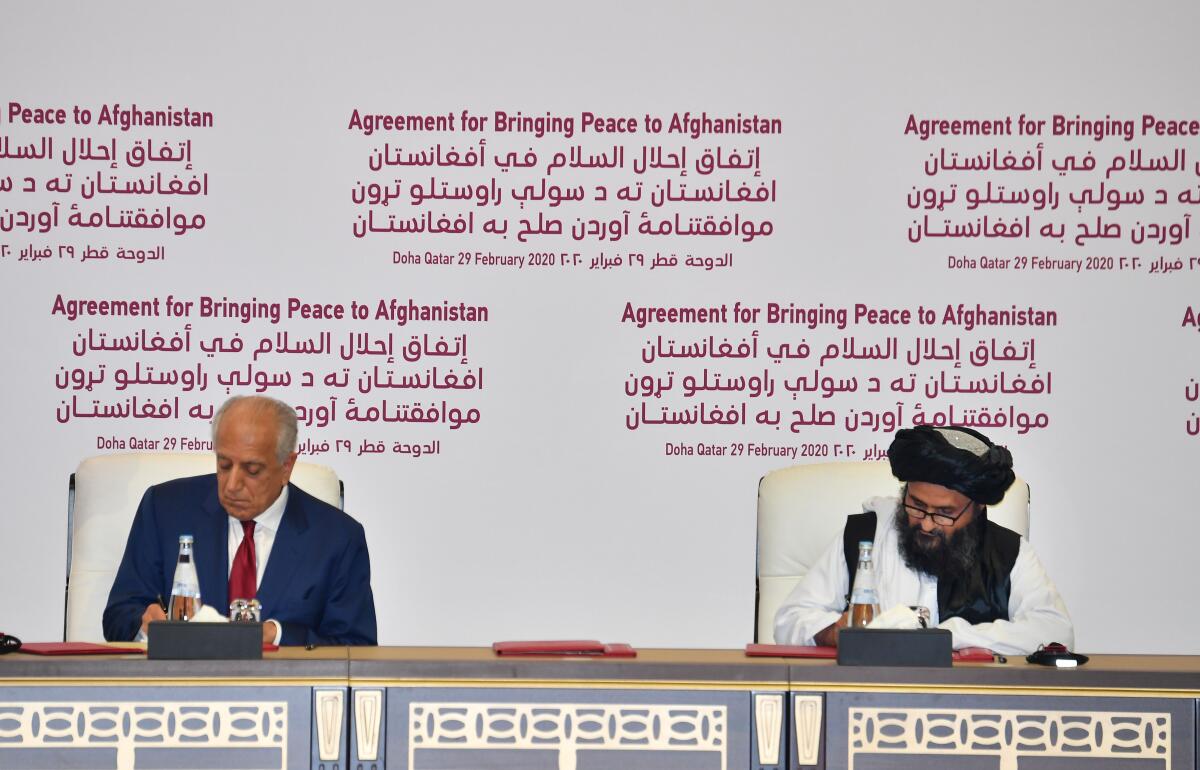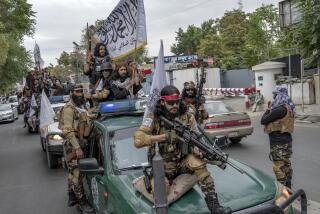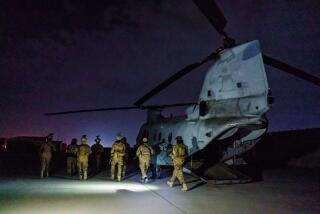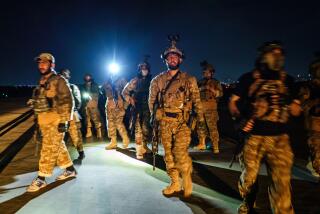U.S. and the Taliban sign accord to end war in Afghanistan, draw down American forces

DOHA, Qatar — The landmark agreement signed Saturday to end the United States’ longest war calls for the U.S. to withdraw its troops from Afghanistan within 14 months, but it is less demanding about what the Taliban needs to do to fight terrorism.
The accord requires Taliban militants to prevent Al Qaeda and other terrorist groups from using Afghan territory to threaten the U.S. But it does not require the militant group to renounce its ties to terrorist groups, an omission that critics said is one of several examples in which the deal appears one-sided.
“Signing this agreement with Taliban is an unacceptable risk to America’s civilian populations,” John Bolton, Trump’s former national security advisor, said Saturday in an unusually harsh tweet hours after the agreement was signed in Doha. “This is an Obama-style deal [that] sends the wrong signal.”
The accord was signed by U.S. and Taliban negotiators side by side in a luxury hotel ballroom in a scene once all but unthinkable. The two sides agreed that the U.S. would cut its troop levels from around 12,000 today to 8,600 by early summer — and eventually withdraw completely from Afghanistan within 14 months if Al Qaeda and other terrorist groups do not reemerge there.
But as current and former officials examined the fine print, they discovered the deal requires the withdrawal not only of U.S. troops, but also some 8,000 military personnel from other countries, who play a key role in training Afghan army and police, plus tens of thousands of contractors and “nondiplomatic” personnel, a designation that would seem to include CIA officers who perform a vital counter-terrorism function in Afghanistan.
“The withdrawals provisions seem far more comprehensive than advertised,” said Brett McGurk, a former Obama and Trump administration envoy. “It’s a total withdrawal ... that would likely produce a gradual collapse of the state, civil war and the Taliban back in Kabul.”
Trump administration officials said the agreement offers perhaps the best opportunity yet for the U.S. to extricate itself from a grinding 19-year war that has cost the lives of more than 2,400 American soldiers and hundreds of thousands of Afghans since it invaded after the terrorist attacks on Sept. 11, 2001, and ousted the Taliban from power.
The onus will be on the Taliban, American officials said, to keep terrorist groups out of Afghanistan and to negotiate a power-sharing agreement with the U.S.-backed Afghan government in Kabul. Otherwise, they warned, the U.S. could halt its troop withdrawals and resume combat operation against the Taliban.
“The agreement we sign today will be the true test,” Secretary of State Michael R. Pompeo said as he opened the ceremony. “We will closely watch the Taliban’s compliance with their commitments and calibrate the pace of our withdrawals to their actions.”
Even a partial pullout would give Trump a signature election-year achievement, enabling him to claim he has followed through on his pledge to scale back overseas wars, a goal that has largely eluded him in Iraq and Syria.
Trump celebrated the agreement at the White House Saturday, opening a news conference focused on the coronavirus by thanking Americans who had fought in Afghanistan over the last two decades.
“Everybody’s tired of war,” Trump said, calling the Afghanistan conflict “a particularly long and gruesome one.”
Answering a reporter’s question about when the drawdown would begin, Trump said: “Like today, OK? Today. They’ll start immediately.” The military has said it would start as soon as logistically possible; and the next negotiations between the Afghan government and Taliban are due to begin March 10 in Oslo.
The president warned that U.S. forces are prepared to return, however, if necessary. “If bad things happen, we’ll go back,” he said. He said Afghanistan’s neighbors are well positioned to help assure future stability there.
In reaching a deal with the Taliban, a coalition of largely ethnic Pashtun militia groups who imposed a harsh form of Islam on the country and allowed Osama bin Laden and other terrorist leaders to operate from their territory, Trump has at least on paper achieved the makings of a potential ending of the conflict.
But the deal is fraught with risks and unknowns that could easily cause it to collapse, former U.S. officials and analysts say.
The looming departure of the U.S. could reignite a four-decade civil war, a conflict that predated the U.S. invasion and that could quickly intensify again as warlords and rival ethnic groups rearm and resume the bloody fighting that left the country one of the poorest in the world.
Some of Trump’s closest allies appear skeptical that the White House is seeking anything other than a rapid end to American involvement in an unpopular war.
“I appreciate the Trump administration’s efforts to end this conflict,” said Sen. Lindsey Graham (R-S.C.) in a tepid statement of support for the deal Saturday. “We have fought too hard and sacrificed too much to allow our security gains to slip away.”
Taliban officials certainly treated the deal as a victory.
Dozens of turbaned, bearded Taliban — some with smartphones, others fingering worry beads — took seats in the red-carpeted hall for the signing, many of them sitting in proximity to current and former U.S. officials, their longtime foes, for the first time. “God is great,” they shouted in unison as the ceremony concluded.
Taliban leaders staged what amounted to a brief victory parade on Doha streets before the signing ceremony, likening the deal to previous triumphs over other foreign powers who sought to occupy Afghanistan, including the British and the Soviets.
“This historic day in our history is a day of pride. Today is the day that our fathers celebrated 30 years and a hundred years ago by defeating Britons and Russians,” said Mohammed Abas Stanekzai, a senior Taliban negotiator, as other Taliban waved the group’s flag and cheered.
A video of the march was posted on YouTube.
“After 20 years of jihad we are celebrating a day that the Islamic Emirate would sign the agreement with the invader Americans, which is about withdrawal of their troops and the victory of Afghanistan mujahedin,” he added, while also warning the Taliban “not to become too arrogant.”
He said the “American invaders” would be gone in 14 months.
Having succeeded in their view in forcing the U.S. to agree to withdraw, Taliban leaders perceive themselves to be in a position of strength, Paul Miller, a former U.S. National Security Council official who oversaw Afghanistan policy said in remarks last week at the Center for National Security, a centrist Washington think tank.
The initial American withdrawals would only return troop numbers to about the same level achieved by President Obama, who oversaw a steep pullout from Afghanistan that Trump reversed a few months after he took office.
In the four-page pact, the U.S. pledged to remove all forces from Afghanistan within 14 months and to begin “immediate” work on freeing some 5,000 Taliban prisoners. It stated that the Taliban “will send a clear message” that Al Qaeda and “those who pose a threat to the security of the United States and its allies have no place in Afghanistan.”
Even the prisoner release plan was criticized by lawmakers such as Rep. Tom Malinowski (D-N.J.), a former State Department human rights official, who said in a tweet that Pompeo “made a commitment to me and other members of Congress” that the Afghan peace deal would not require prisoner releases.
The deal was finalized after a weeklong pause in fighting that saw attacks across Afghanistan drop sharply.
It commits the Taliban to an eventual cease-fire and to holding talks for the first time with the U.S-backed government in Kabul on a political settlement of the conflict — conditions the militant group has steadfastly rejected in the past.
But Taliban negotiators set aside those objections in return for a pledge by the U.S. to withdraw its forces, the group’s longtime goal and one that meshed with Trump’s own desire to bring troops home in the middle of an election year.
The Kabul government only grudgingly agreed to begin power-sharing talks with the Taliban after U.S. envoy Zalmay Khalilzad opened direct talks with the Taliban for the first time last year. That raised concern from President Ashraf Ghani and other officials in Kabul that the U.S. was willing to reach a separate peace with their longtime foes.
Ahead of the signing of the deal in Doha, Ghani met with Secretary of Defense Mark Esper and NATO’s Secretary-General Jens Stoltenberg in Kabul.
“Our sacrifice has been immense,” Ghani said while addressing the nation. “U.S. and NATO partners have spared neither blood nor treasure. Today can be the moment of overcoming the past, of sustained, dignified peace. We have the political will to bring this peace.”
The timing of the the next round of talks could hardly be worse for Ghani, the Afghan president, who this month was declared the winner of presidential elections — nearly five contentious months after the vote. His chief rival, Abdullah Abdullah, has refused to recognize that outcome and declared himself the victor.
The standoff has delayed appointment of a government negotiating team for the talks with the Taliban.
The two sides appear far apart, with Ghani and his advisors seemingly intent on a deal that allows the Taliban to join the government, while Taliban negotiators appear to have in mind a more far-reaching overhaul that would give them a major voice in running the country.
Without continuing U.S. pressure on the Taliban, its leaders could quickly back away from the agreement, or the Afghan government could become mired its own internal divisions, analysts said.
There are also growing fears especially among Afghanistan’s urban population that the Taliban militants could reclaim power in some areas of the country and take away women’s rights and other hard-won freedoms as they seek to reimpose their harsh form of Islamic law.
U.S. officials said they will have a seat at the talks in Oslo and will press for protecting women’s and minority rights, as well as for the survival of the Afghan government, which remains racked by corruption and unable to fully control large parts of the country.
“A high priority for us is absolutely the protection of women’s rights,” a senior State Department official told reporters in Washington. “We will use our voice.”
But keeping the talks on track will require the U.S. to use the leverage it still has over the Taliban to force them to make a deal. That leverage includes threatening to withhold international aid, on which Afghanistan is heavily dependent, analysts said.
U.S. officials also insist that the timetable for reducing troop levels below 8,600 will depend on conditions in the country — specifically the Taliban’s adherence to its promise not to allow Al Qaeda and other terrorist groups to reestablish a presence on Afghan territory.
Both sides are likely to continue to limit attacks in hopes a cease-fire will take hold in the coming weeks. The U.S. and its allies plan to continue training and upgrading the equipment of the Afghan army and police while the talks are underway. And the U.S. military says it will continue to carry out counter-terrorism operations against Islamic State, which has fighters in eastern parts of the country.
The U.S. could also delay additional withdrawals if the Oslo talks collapse or the Taliban refuses to negotiate in good faith, though it’s unclear whether Trump would decide to halt the pullout in that case.
“If the talks fail there is nothing in the agreement that obliges the United States to withdraw its troops,” said the official, who briefed reporters on the condition of not being named. “That’s not to say that the president doesn’t have prerogatives as commander in chief to make any decision he feels is appropriate.”
Cloud reported from Doha, Wilkinson from Washington and special correspondent Glinski from Kabul.
More to Read
Sign up for Essential California
The most important California stories and recommendations in your inbox every morning.
You may occasionally receive promotional content from the Los Angeles Times.












